Anna Kukleva
Max Planck Institute for Informatics, Saarland Informatics Campus
RefAM: Attention Magnets for Zero-Shot Referral Segmentation
Sep 26, 2025
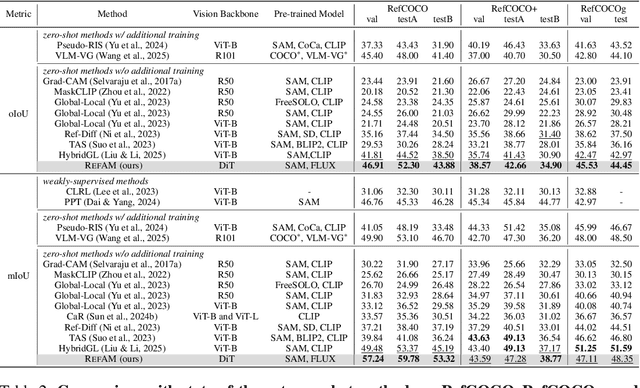


Abstract:Most existing approaches to referring segmentation achieve strong performance only through fine-tuning or by composing multiple pre-trained models, often at the cost of additional training and architectural modifications. Meanwhile, large-scale generative diffusion models encode rich semantic information, making them attractive as general-purpose feature extractors. In this work, we introduce a new method that directly exploits features, attention scores, from diffusion transformers for downstream tasks, requiring neither architectural modifications nor additional training. To systematically evaluate these features, we extend benchmarks with vision-language grounding tasks spanning both images and videos. Our key insight is that stop words act as attention magnets: they accumulate surplus attention and can be filtered to reduce noise. Moreover, we identify global attention sinks (GAS) emerging in deeper layers and show that they can be safely suppressed or redirected onto auxiliary tokens, leading to sharper and more accurate grounding maps. We further propose an attention redistribution strategy, where appended stop words partition background activations into smaller clusters, yielding sharper and more localized heatmaps. Building on these findings, we develop RefAM, a simple training-free grounding framework that combines cross-attention maps, GAS handling, and redistribution. Across zero-shot referring image and video segmentation benchmarks, our approach consistently outperforms prior methods, establishing a new state of the art without fine-tuning or additional components.
VideoGEM: Training-free Action Grounding in Videos
Mar 26, 2025Abstract:Vision-language foundation models have shown impressive capabilities across various zero-shot tasks, including training-free localization and grounding, primarily focusing on localizing objects in images. However, leveraging those capabilities to localize actions and events in videos is challenging, as actions have less physical outline and are usually described by higher-level concepts. In this work, we propose VideoGEM, the first training-free spatial action grounding method based on pretrained image- and video-language backbones. Namely, we adapt the self-self attention formulation of GEM to spatial activity grounding. We observe that high-level semantic concepts, such as actions, usually emerge in the higher layers of the image- and video-language models. We, therefore, propose a layer weighting in the self-attention path to prioritize higher layers. Additionally, we introduce a dynamic weighting method to automatically tune layer weights to capture each layer`s relevance to a specific prompt. Finally, we introduce a prompt decomposition, processing action, verb, and object prompts separately, resulting in a better spatial localization of actions. We evaluate the proposed approach on three image- and video-language backbones, CLIP, OpenCLIP, and ViCLIP, and on four video grounding datasets, V-HICO, DALY, YouCook-Interactions, and GroundingYouTube, showing that the proposed training-free approach is able to outperform current trained state-of-the-art approaches for spatial video grounding.
T-FAKE: Synthesizing Thermal Images for Facial Landmarking
Aug 27, 2024


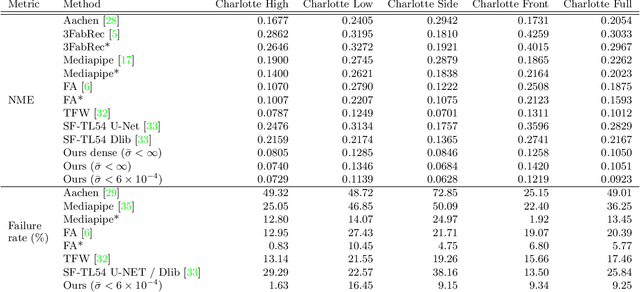
Abstract:Facial analysis is a key component in a wide range of applications such as security, autonomous driving, entertainment, and healthcare. Despite the availability of various facial RGB datasets, the thermal modality, which plays a crucial role in life sciences, medicine, and biometrics, has been largely overlooked. To address this gap, we introduce the T-FAKE dataset, a new large-scale synthetic thermal dataset with sparse and dense landmarks. To facilitate the creation of the dataset, we propose a novel RGB2Thermal loss function, which enables the transfer of thermal style to RGB faces. By utilizing the Wasserstein distance between thermal and RGB patches and the statistical analysis of clinical temperature distributions on faces, we ensure that the generated thermal images closely resemble real samples. Using RGB2Thermal style transfer based on our RGB2Thermal loss function, we create the T-FAKE dataset, a large-scale synthetic thermal dataset of faces. Leveraging our novel T-FAKE dataset, probabilistic landmark prediction, and label adaptation networks, we demonstrate significant improvements in landmark detection methods on thermal images across different landmark conventions. Our models show excellent performance with both sparse 70-point landmarks and dense 478-point landmark annotations. Our code and models are available at https://github.com/phflot/tfake.
X-MIC: Cross-Modal Instance Conditioning for Egocentric Action Generalization
Mar 28, 2024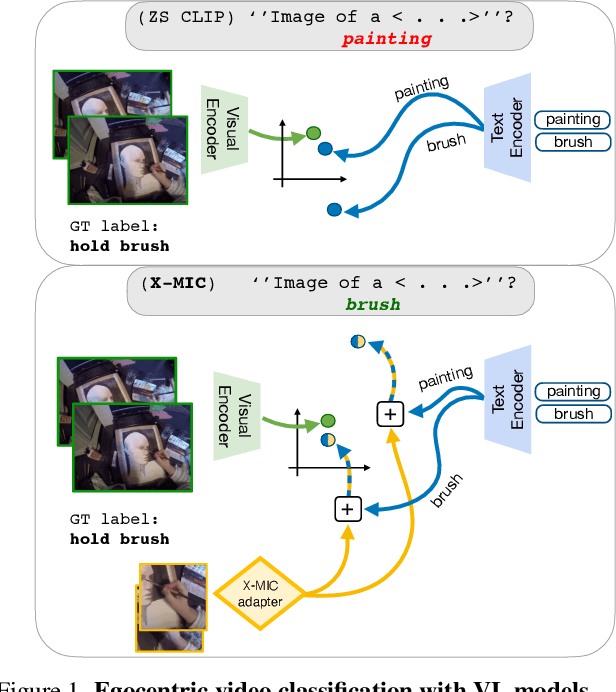

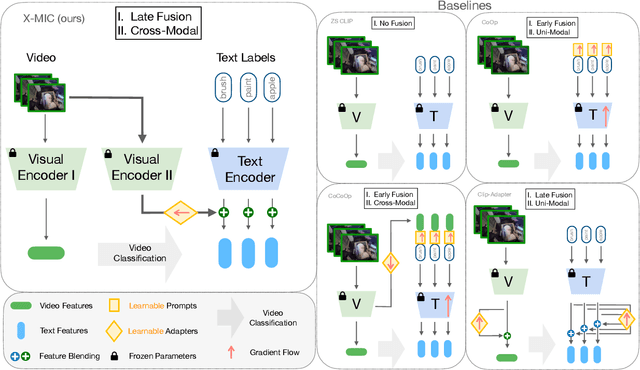

Abstract:Lately, there has been growing interest in adapting vision-language models (VLMs) to image and third-person video classification due to their success in zero-shot recognition. However, the adaptation of these models to egocentric videos has been largely unexplored. To address this gap, we propose a simple yet effective cross-modal adaptation framework, which we call X-MIC. Using a video adapter, our pipeline learns to align frozen text embeddings to each egocentric video directly in the shared embedding space. Our novel adapter architecture retains and improves generalization of the pre-trained VLMs by disentangling learnable temporal modeling and frozen visual encoder. This results in an enhanced alignment of text embeddings to each egocentric video, leading to a significant improvement in cross-dataset generalization. We evaluate our approach on the Epic-Kitchens, Ego4D, and EGTEA datasets for fine-grained cross-dataset action generalization, demonstrating the effectiveness of our method. Code is available at https://github.com/annusha/xmic
OrCo: Towards Better Generalization via Orthogonality and Contrast for Few-Shot Class-Incremental Learning
Mar 27, 2024Abstract:Few-Shot Class-Incremental Learning (FSCIL) introduces a paradigm in which the problem space expands with limited data. FSCIL methods inherently face the challenge of catastrophic forgetting as data arrives incrementally, making models susceptible to overwriting previously acquired knowledge. Moreover, given the scarcity of labeled samples available at any given time, models may be prone to overfitting and find it challenging to strike a balance between extensive pretraining and the limited incremental data. To address these challenges, we propose the OrCo framework built on two core principles: features' orthogonality in the representation space, and contrastive learning. In particular, we improve the generalization of the embedding space by employing a combination of supervised and self-supervised contrastive losses during the pretraining phase. Additionally, we introduce OrCo loss to address challenges arising from data limitations during incremental sessions. Through feature space perturbations and orthogonality between classes, the OrCo loss maximizes margins and reserves space for the following incremental data. This, in turn, ensures the accommodation of incoming classes in the feature space without compromising previously acquired knowledge. Our experimental results showcase state-of-the-art performance across three benchmark datasets, including mini-ImageNet, CIFAR100, and CUB datasets. Code is available at https://github.com/noorahmedds/OrCo
SSB: Simple but Strong Baseline for Boosting Performance of Open-Set Semi-Supervised Learning
Nov 17, 2023



Abstract:Semi-supervised learning (SSL) methods effectively leverage unlabeled data to improve model generalization. However, SSL models often underperform in open-set scenarios, where unlabeled data contain outliers from novel categories that do not appear in the labeled set. In this paper, we study the challenging and realistic open-set SSL setting, where the goal is to both correctly classify inliers and to detect outliers. Intuitively, the inlier classifier should be trained on inlier data only. However, we find that inlier classification performance can be largely improved by incorporating high-confidence pseudo-labeled data, regardless of whether they are inliers or outliers. Also, we propose to utilize non-linear transformations to separate the features used for inlier classification and outlier detection in the multi-task learning framework, preventing adverse effects between them. Additionally, we introduce pseudo-negative mining, which further boosts outlier detection performance. The three ingredients lead to what we call Simple but Strong Baseline (SSB) for open-set SSL. In experiments, SSB greatly improves both inlier classification and outlier detection performance, outperforming existing methods by a large margin. Our code will be released at https://github.com/YUE-FAN/SSB.
HowToCaption: Prompting LLMs to Transform Video Annotations at Scale
Oct 07, 2023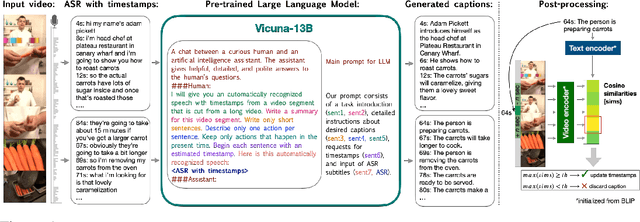
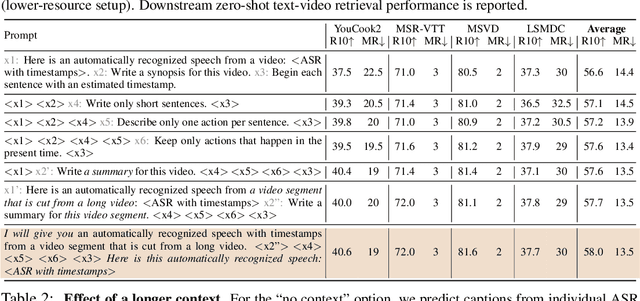
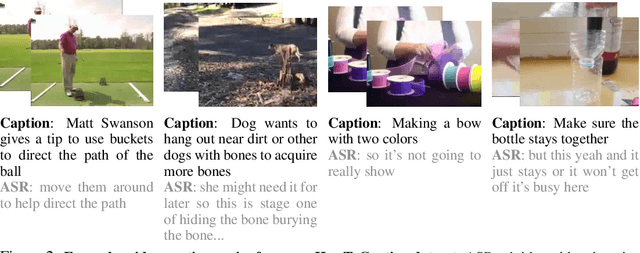

Abstract:Instructional videos are an excellent source for learning multimodal representations by leveraging video-subtitle pairs extracted with automatic speech recognition systems (ASR) from the audio signal in the videos. However, in contrast to human-annotated captions, both speech and subtitles naturally differ from the visual content of the videos and thus provide only noisy supervision for multimodal learning. As a result, large-scale annotation-free web video training data remains sub-optimal for training text-video models. In this work, we propose to leverage the capability of large language models (LLMs) to obtain fine-grained video descriptions aligned with videos. Specifically, we prompt an LLM to create plausible video descriptions based on ASR narrations of the video for a large-scale instructional video dataset. To this end, we introduce a prompting method that is able to take into account a longer text of subtitles, allowing us to capture context beyond a single sentence. To align the captions to the video temporally, we prompt the LLM to generate timestamps for each produced caption based on the subtitles. In this way, we obtain human-style video captions at scale without human supervision. We apply our method to the subtitles of the HowTo100M dataset, creating a new large-scale dataset, HowToCaption. Our evaluation shows that the resulting captions not only significantly improve the performance over many different benchmark datasets for text-video retrieval but also lead to a disentangling of textual narration from the audio, boosting performance in text-video-audio tasks.
In-Style: Bridging Text and Uncurated Videos with Style Transfer for Text-Video Retrieval
Sep 16, 2023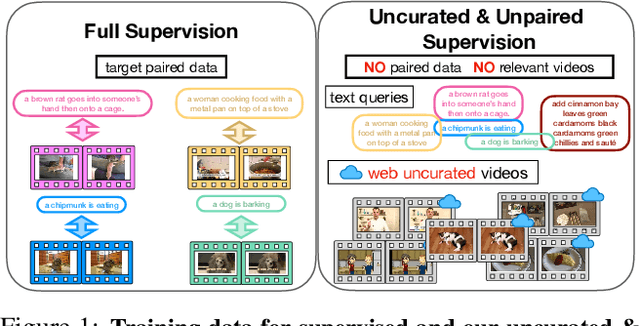



Abstract:Large-scale noisy web image-text datasets have been proven to be efficient for learning robust vision-language models. However, when transferring them to the task of video retrieval, models still need to be fine-tuned on hand-curated paired text-video data to adapt to the diverse styles of video descriptions. To address this problem without the need for hand-annotated pairs, we propose a new setting, text-video retrieval with uncurated & unpaired data, that during training utilizes only text queries together with uncurated web videos without any paired text-video data. To this end, we propose an approach, In-Style, that learns the style of the text queries and transfers it to uncurated web videos. Moreover, to improve generalization, we show that one model can be trained with multiple text styles. To this end, we introduce a multi-style contrastive training procedure that improves the generalizability over several datasets simultaneously. We evaluate our model on retrieval performance over multiple datasets to demonstrate the advantages of our style transfer framework on the new task of uncurated & unpaired text-video retrieval and improve state-of-the-art performance on zero-shot text-video retrieval.
Temperature Schedules for Self-Supervised Contrastive Methods on Long-Tail Data
Mar 23, 2023Abstract:Most approaches for self-supervised learning (SSL) are optimised on curated balanced datasets, e.g. ImageNet, despite the fact that natural data usually exhibits long-tail distributions. In this paper, we analyse the behaviour of one of the most popular variants of SSL, i.e. contrastive methods, on long-tail data. In particular, we investigate the role of the temperature parameter $\tau$ in the contrastive loss, by analysing the loss through the lens of average distance maximisation, and find that a large $\tau$ emphasises group-wise discrimination, whereas a small $\tau$ leads to a higher degree of instance discrimination. While $\tau$ has thus far been treated exclusively as a constant hyperparameter, in this work, we propose to employ a dynamic $\tau$ and show that a simple cosine schedule can yield significant improvements in the learnt representations. Such a schedule results in a constant `task switching' between an emphasis on instance discrimination and group-wise discrimination and thereby ensures that the model learns both group-wise features, as well as instance-specific details. Since frequent classes benefit from the former, while infrequent classes require the latter, we find this method to consistently improve separation between the classes in long-tail data without any additional computational cost.
TAEC: Unsupervised Action Segmentation with Temporal-Aware Embedding and Clustering
Mar 09, 2023
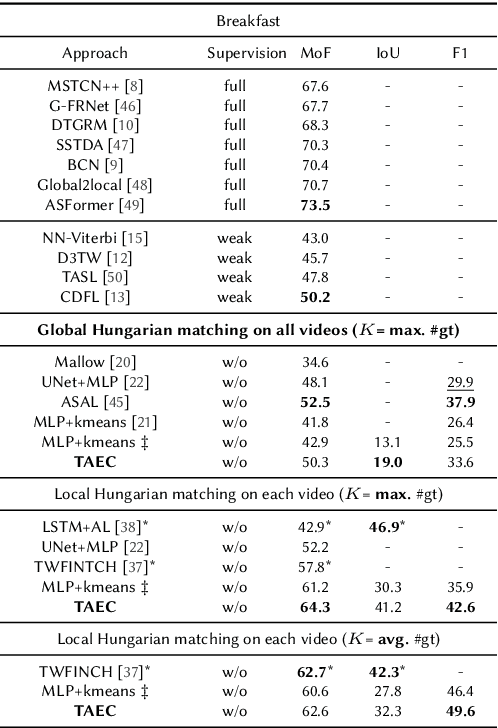
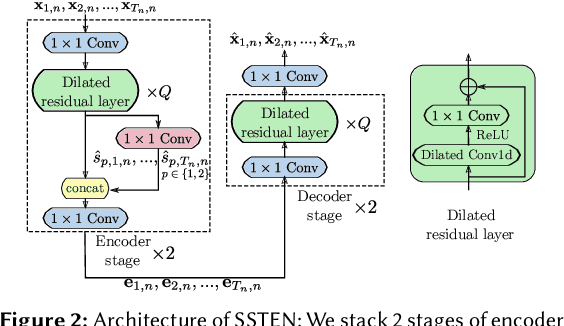
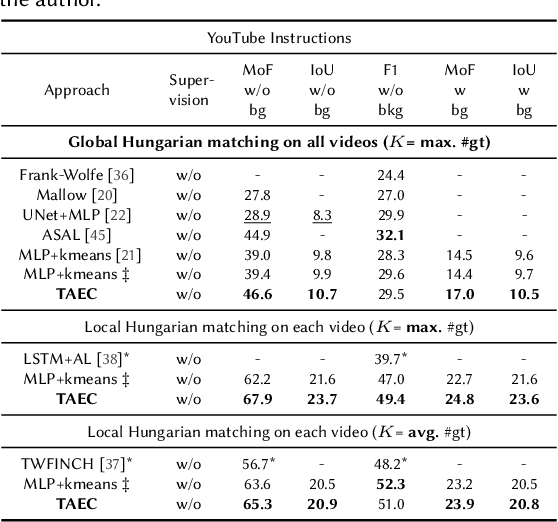
Abstract:Temporal action segmentation in untrimmed videos has gained increased attention recently. However, annotating action classes and frame-wise boundaries is extremely time consuming and cost intensive, especially on large-scale datasets. To address this issue, we propose an unsupervised approach for learning action classes from untrimmed video sequences. In particular, we propose a temporal embedding network that combines relative time prediction, feature reconstruction, and sequence-to-sequence learning, to preserve the spatial layout and sequential nature of the video features. A two-step clustering pipeline on these embedded feature representations then allows us to enforce temporal consistency within, as well as across videos. Based on the identified clusters, we decode the video into coherent temporal segments that correspond to semantically meaningful action classes. Our evaluation on three challenging datasets shows the impact of each component and, furthermore, demonstrates our state-of-the-art unsupervised action segmentation results.
 Add to Chrome
Add to Chrome Add to Firefox
Add to Firefox Add to Edge
Add to Edge